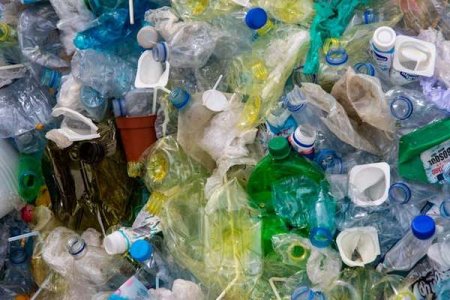No plastics allowed: Surprising ways to lower 'forever chemicals' exposure in Australia
By
Danielle F.
- Replies 0
Aussies keeping an eye on the news might have heard the term 'forever chemicals' at some point.
While these mysterious substances have been afloat lately, Aussies are wondering if everyone should be worried about them.
What are these 'forever chemicals'?
Forever chemicals have been the moniker for PFAS, or per- and poly-fluoroalkyl substances!
While the name may be a mouthful, these are synthetic chemicals used in a wide range of products since the 1950s.
They're used for fashion, cookware, home products, food packaging, and even cosmetics.

These chemicals are heat, water, grease, and stain-resistant, making them useful in everyday life.
However, as their name states, these chemicals do not break down easily in the environment or in people's bodies.
Where do PFAS come from?
PFAS can enter bodies in a few ways:
How common are PFAS in Australia?
'I'm afraid every person in Australia has PFAS levels in their body,' Professor Peter Sly from the Queensland Children's Medical Research Institute recently told a federal inquiry.
'It's a matter of how high they are.'
To back Professor Sly's claim, recent data from the Australian Bureau of Statistics (ABS) stated that over 85 per cent of Australians tested had at least three types of PFAS in their blood.
While researchers can currently test for about 40 different types, more than 15,000 known PFAS compounds exist out there.
What do we know about the health risks?
While some studies linked higher PFAS levels to health issues like increased cholesterol, immune system effects, and certain types of cancer, the evidence hasn't been consistent.
The long-term effects of low-level exposure are still unclear, and more research is needed.
Professor Martyn Kirk from the Australian National University pointed out that people still have 'blind spots' when it comes to PFAS, including:
Can Aussies reduce PFAS levels in their body?
A world-first Australian study in 2022 found that donating blood or plasma could lower PFAS levels in the body.
The study looked at 285 firefighters and found that:
Other studies also found that PFAS levels in women are lower due to their menstruation cycle.
However, researchers cautioned that there are no apparent benefits yet from lowering PFAS levels this way.
Hence, more research may be conducted to understand the implications.
Learn more about PFAS contamination and how it's affecting Australia's food sector:
Source: ABC News Australia/YouTube
What's being done about PFAS in Australia?
Companies across Australia have started phasing out some PFAS since the late 1990s and early 2000s.
Since then, PFAS levels in Australians' blood have dropped by nearly tenfold since 2000.
However, PFAS are still out there, and some communities are worried about ongoing contamination and possible health effects.
What can you do to limit your exposure?
While it's impossible to avoid PFAS altogether, you can take a few steps to reduce your exposure:

Have you heard about 'forever chemicals' before? Are you concerned about PFAS in your home or community? Have you taken any steps to reduce your exposure? We would love to hear your thoughts and experiences with these chemicals, and how to lessen exposure to them in the comments section below.
MORE NEWS: New Australian data shows most of us have PFAS in our blood. How worried should we be?
While these mysterious substances have been afloat lately, Aussies are wondering if everyone should be worried about them.
What are these 'forever chemicals'?
Forever chemicals have been the moniker for PFAS, or per- and poly-fluoroalkyl substances!
While the name may be a mouthful, these are synthetic chemicals used in a wide range of products since the 1950s.
They're used for fashion, cookware, home products, food packaging, and even cosmetics.

Plastic bottles are one of the common sources of these forever chemicals. Image Credit: Pexels/Magda Ehlers
These chemicals are heat, water, grease, and stain-resistant, making them useful in everyday life.
However, as their name states, these chemicals do not break down easily in the environment or in people's bodies.
Where do PFAS come from?
PFAS can enter bodies in a few ways:
- Food and water: This happens when food is packaged in PFAS-treated material or if drinking water is affected by industrial runoff.
- Household products: Non-stick cookware, stain-resistant fabrics, and some cleaning products can all be sources of PFAS.
- Occupational exposure: Firefighters have historically been exposed to high levels of PFAS through firefighting foams.
How common are PFAS in Australia?
'I'm afraid every person in Australia has PFAS levels in their body,' Professor Peter Sly from the Queensland Children's Medical Research Institute recently told a federal inquiry.
'It's a matter of how high they are.'
To back Professor Sly's claim, recent data from the Australian Bureau of Statistics (ABS) stated that over 85 per cent of Australians tested had at least three types of PFAS in their blood.
While researchers can currently test for about 40 different types, more than 15,000 known PFAS compounds exist out there.
What do we know about the health risks?
While some studies linked higher PFAS levels to health issues like increased cholesterol, immune system effects, and certain types of cancer, the evidence hasn't been consistent.
The long-term effects of low-level exposure are still unclear, and more research is needed.
Professor Martyn Kirk from the Australian National University pointed out that people still have 'blind spots' when it comes to PFAS, including:
- The long-term health impacts of low exposure
- The effects on people with very high exposure (like firefighters)
- The primary sources of exposure in our homes
- The best ways to reduce PFAS in our bodies
Can Aussies reduce PFAS levels in their body?
A world-first Australian study in 2022 found that donating blood or plasma could lower PFAS levels in the body.
The study looked at 285 firefighters and found that:
- Donating blood every 12 weeks reduced PFAS levels by about 10 per cent
- Donating plasma every 6 weeks could also lower PFAS levels by about 30 per cent
Other studies also found that PFAS levels in women are lower due to their menstruation cycle.
However, researchers cautioned that there are no apparent benefits yet from lowering PFAS levels this way.
Hence, more research may be conducted to understand the implications.
Learn more about PFAS contamination and how it's affecting Australia's food sector:
Source: ABC News Australia/YouTube
What's being done about PFAS in Australia?
Companies across Australia have started phasing out some PFAS since the late 1990s and early 2000s.
Since then, PFAS levels in Australians' blood have dropped by nearly tenfold since 2000.
However, PFAS are still out there, and some communities are worried about ongoing contamination and possible health effects.
What can you do to limit your exposure?
While it's impossible to avoid PFAS altogether, you can take a few steps to reduce your exposure:
- Choose PFAS-free products: Look for cookware, clothing, and food packaging labelled as PFAS-free.
- Avoid stain-resistant treatments: Skip carpets and furniture that have been treated to resist stains.
- Be cautious with non-stick cookware: If your pans are scratched or worn, consider replacing them with stainless steel or cast iron.
- Check your local water quality: If you live near a known contamination site, consider using a water filter that removes PFAS.
Key Takeaways
- Most Australians have some level of 'forever chemicals' in their bodies, but there are still significant gaps on how these chemicals affect people's health.
- Blood and plasma donation could significantly reduce PFAS levels in the body, though the long-term health benefits of this reduction remain unclear.
- Scientists called for more research to understand better sources of PFAS exposure, long-term health impacts, and ways to reduce these chemicals.
- While PFAS levels in Australians have dropped markedly since the early 2000s, concerns remain for highly exposed groups, highlighting the need for clear information and good policy decisions.
MORE NEWS: New Australian data shows most of us have PFAS in our blood. How worried should we be?







